Pecharsky V.K., Zavalij P.Y. Fundamentals of Powder Diffraction and Structural Characterization of Materials
Подождите немного. Документ загружается.

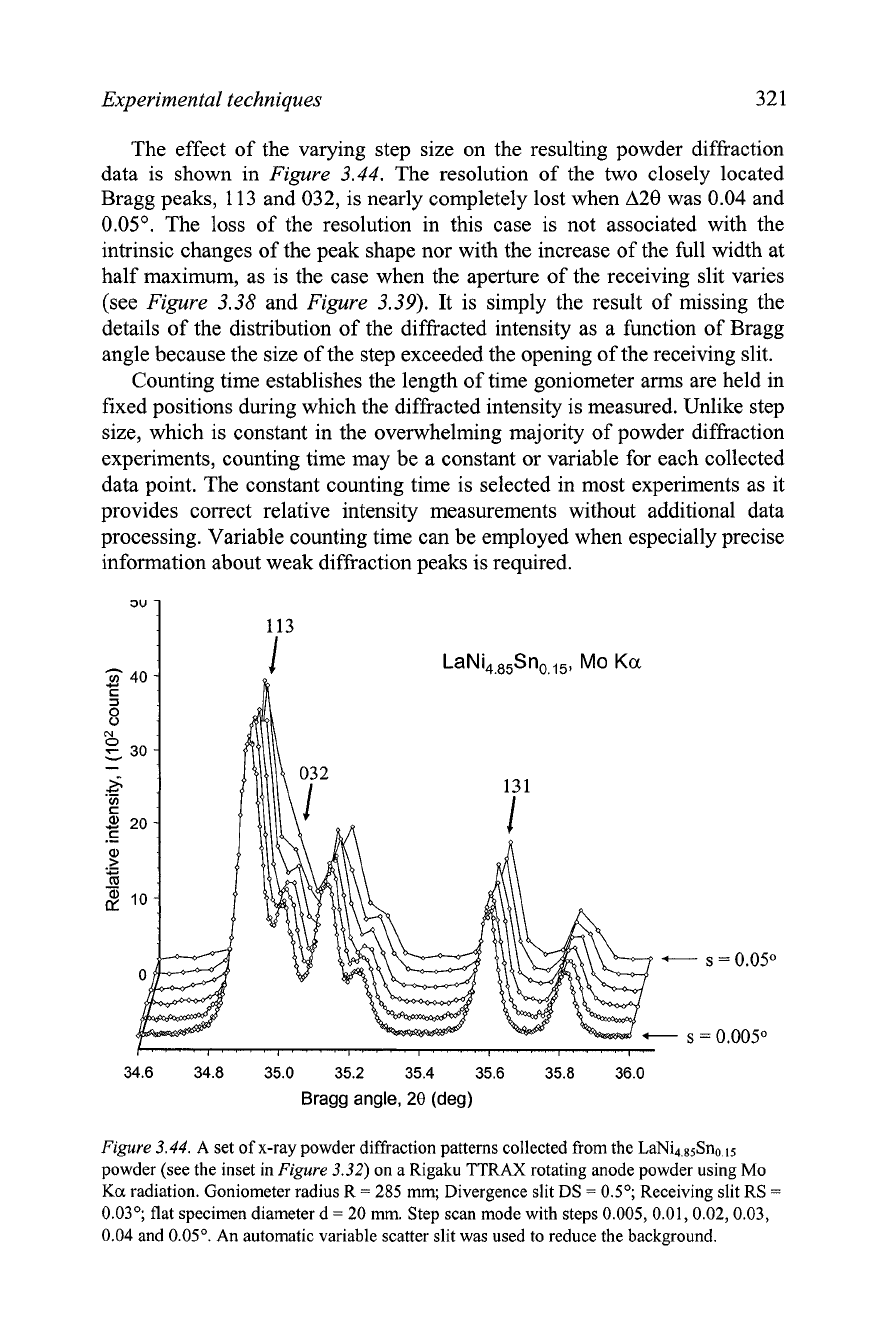
Experimental techniques
32
1
The effect of the varying step size on the resulting powder diffraction
data is shown in
Figure
3.44.
The resolution of the two closely located
Bragg peaks,
113
and 032, is nearly completely lost when
A28
was 0.04 and
0.05'. The loss of the resolution in this case is not associated with the
intrinsic changes of the peak shape nor with the increase of the full width at
half maximum, as is the case when the aperture of the receiving slit varies
(see
Figure
3.38
and
Figure
3.39).
It is simply the result of missing the
details of the distribution of the diffracted intensity as a function of Bragg
angle because the size of the step exceeded the opening of the receiving slit.
Counting time establishes the length of time goniometer arms are held in
fixed positions during which the diffracted intensity is measured. Unlike step
size, which is constant in the overwhelming majority of powder diffraction
experiments, counting time may be a constant or variable for each collected
data point. The constant counting time is selected in most experiments as it
provides correct relative intensity measurements without additional data
processing. Variable counting time can be employed when especially precise
information about weak diffraction peaks is required.
Figure 3.44.
A
set of x-ray powder diffraction patterns collected from the LaNi4.ssSno
Is
powder (see the inset in
Figure
3.32)
on a Rigaku TTRAX rotating anode powder using Mo
Kcr
radiation. Goniometer radius R
=
285 mm; Divergence slit DS
=
0.5'; Receiving slit RS
=
0.03"; flat specimen diameter d
=
20
mrn.
Step scan mode with steps 0.005,0.01,0.02,0.03,
0.04 and 0.05". An automatic variable scatter slit was used to reduce the background.
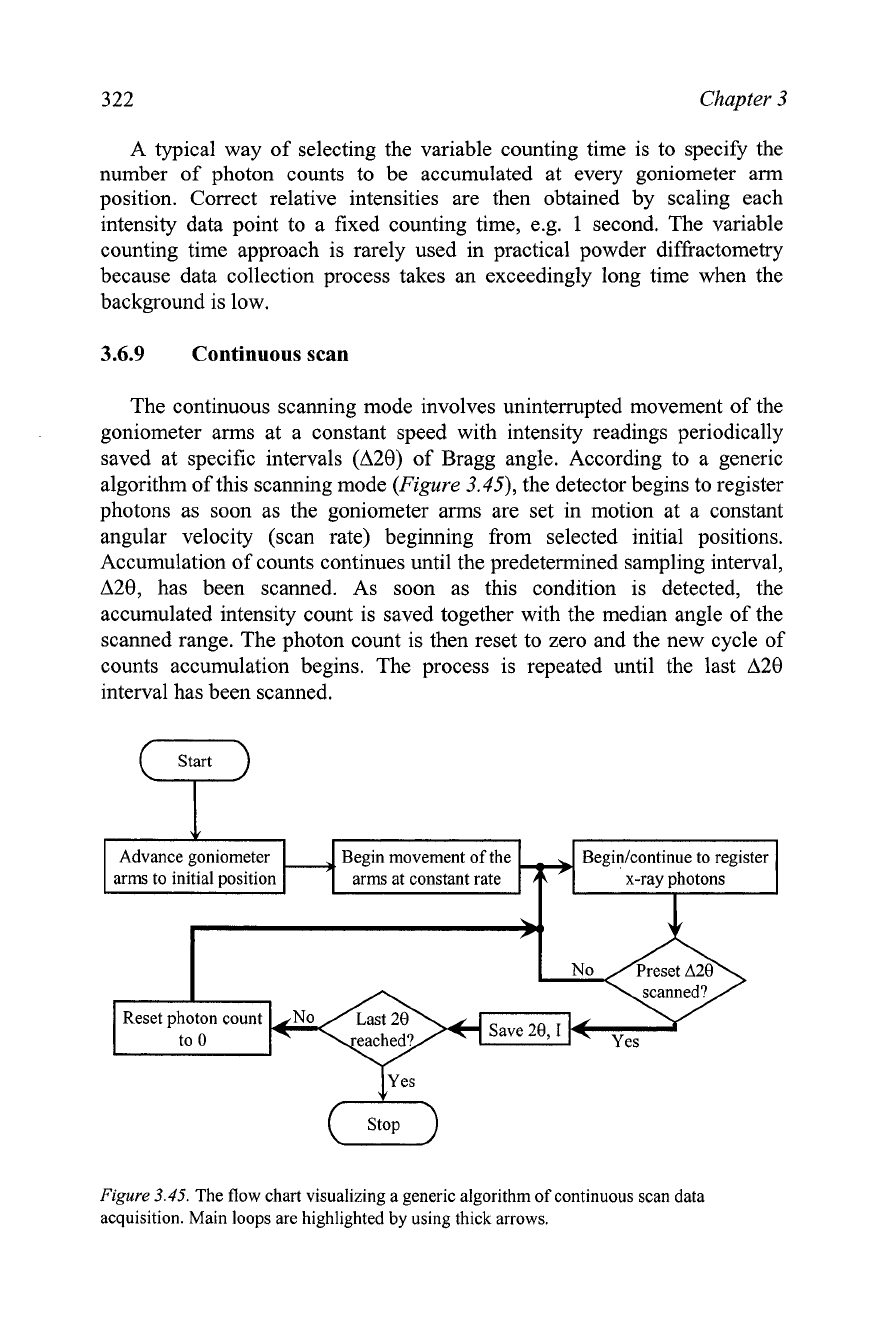
322 Chapter 3
A typical way of selecting the variable counting time is to specify the
number of photon counts to be accumulated at every goniometer arm
position. Correct relative intensities are then obtained by scaling each
intensity data point to a fixed counting time,
e.g.
1
second. The variable
counting time approach is rarely used in practical powder diffractometry
because data collection process takes an exceedingly long time when the
background is low.
3.6.9 Continuous scan
The continuous scanning mode involves uninterrupted movement of the
goniometer arms at a constant speed with intensity readings periodically
saved at specific intervals
(820) of Bragg angle. According to a generic
algorithm of this scanning mode (Figure 3.45), the detector begins to register
photons as soon as the goniometer arms are set in motion at a constant
angular velocity (scan rate) beginning from selected initial positions.
Accumulation of counts continues until the predetermined sampling interval,
828, has been scanned. As soon as this condition is detected, the
accumulated intensity count is saved together with the median angle of the
scanned range. The photon count is then reset to zero and the new cycle of
counts accumulation begins. The process is repeated until the last A29
interval has been scanned.
Start
5'
J.
Advance goniometer
,,
Begin movement of the Beginlcontinue to register
arms to initial position arms at constant rate x-ray photons
I
\scann~
Reset photon count
Figure
3.45.
The flow chart visualizing a generic algorithm of continuous scan data
acquisition. Main loops are highlighted by using thick arrows.
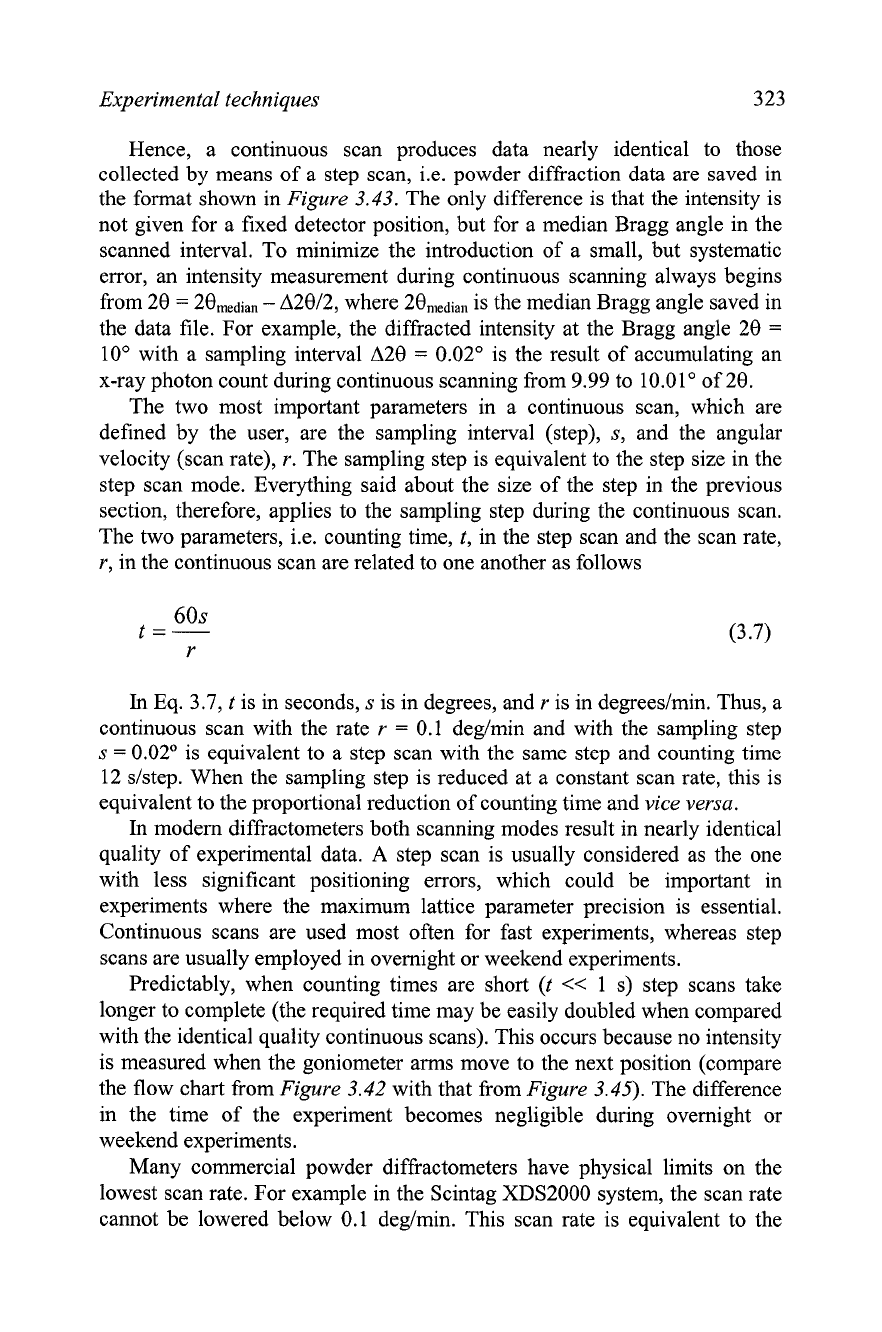
Experimental techniques 323
Hence, a continuous scan produces data nearly identical to those
collected by means of a step scan, i.e. powder
diffraction
data are saved in
the format shown in Figure
3.43.
The only difference is that the intensity is
not given for a fixed detector position, but for a median Bragg angle in the
scanned interval. To minimize the introduction of a small, but systematic
error, an intensity measurement during continuous scanning always begins
from 20
=
20mdia,
-
A2012, where 29,dia,, is the median Bragg angle saved in
the data file. For example, the diffracted intensity at the Bragg angle 20
=
10" with a sampling interval A20
=
0.02" is the result of accumulating an
x-ray photon count during continuous scanning from
9.99
to 10.01" of 20.
The two most important parameters in a continuous scan, which are
defined by the user, are the sampling interval (step), s, and the angular
velocity (scan rate), r. The sampling step is equivalent to the step size in the
step scan mode. Everything said about the size of the step in the previous
section, therefore, applies to the sampling step during the continuous scan.
The two parameters, i.e. counting time, t, in the step scan and the scan rate,
r, in the continuous scan are related to one another as follows
In
Eq. 3.7, t is in seconds,
s
is in degrees, and r is in degreeslmin. Thus, a
continuous scan with the rate r
=
0.1 deglmin and with the sampling step
s
=
0.02" is equivalent to a step scan with the same step and counting time
12 slstep. When the sampling step is reduced at a constant scan rate, this is
equivalent to the proportional reduction of counting time and vice versa.
In
modern diffractometers both scanning modes result in nearly identical
quality of experimental data.
A
step scan is usually considered as the one
with less significant positioning errors, which could be important in
experiments where the maximum lattice parameter precision is essential.
Continuous scans are used most often for fast experiments, whereas step
scans are usually employed in overnight or weekend experiments.
Predictably, when counting times are short (t
<<
1
s) step scans take
longer to complete (the required time may be easily doubled when compared
with the identical quality continuous scans). This occurs because no intensity
is measured when the goniometer arms move to the next position (compare
the flow chart from Figure 3.42 with that from Figure 3.45). The difference
in the time of the experiment becomes negligible during overnight or
weekend experiments.
Many commercial powder diffractometers have physical limits on the
lowest scan rate. For example in the Scintag
XDS2000 system, the scan rate
cannot be lowered below 0.1 deglmin. This scan rate is equivalent to the
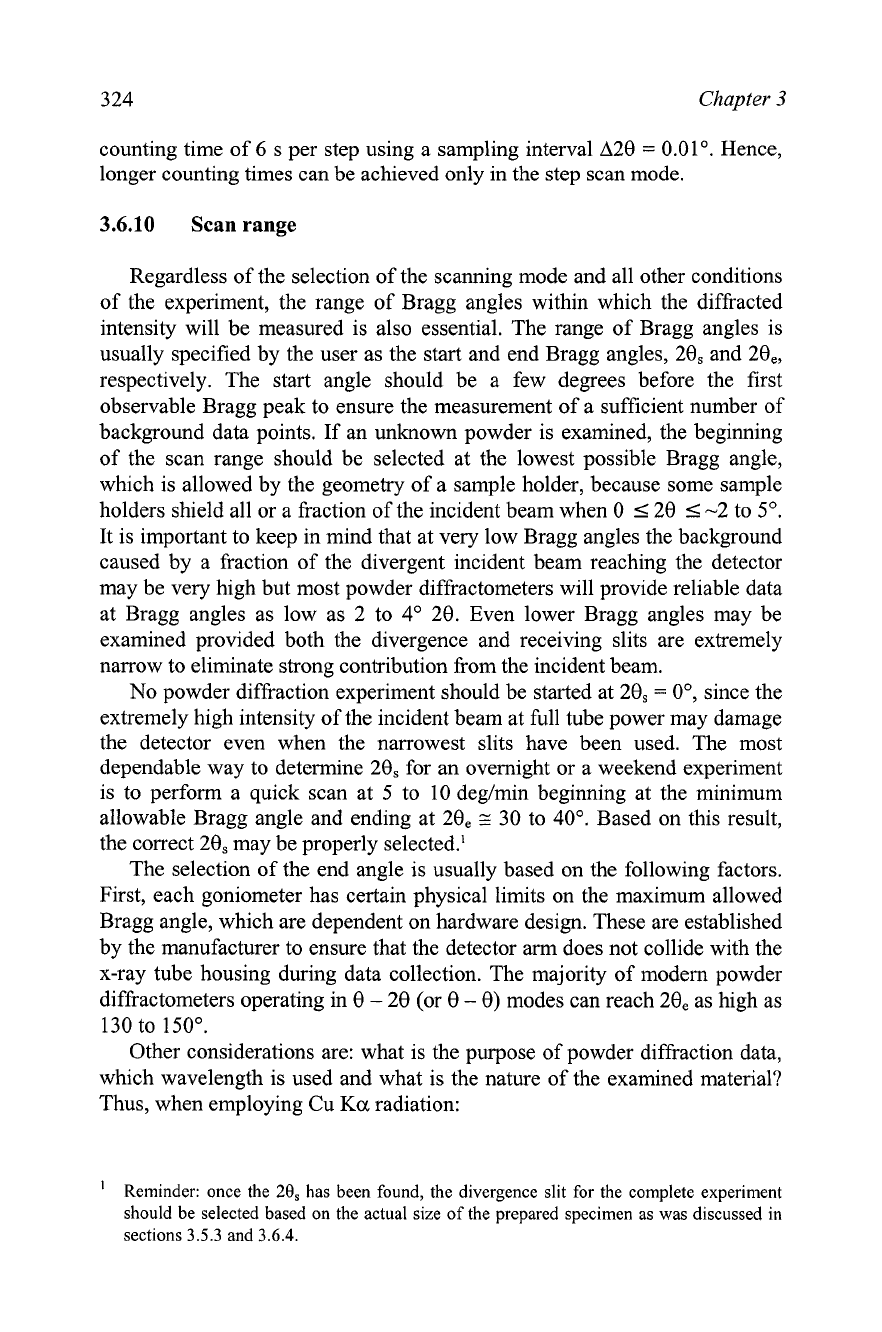
3 24
Chapter
3
counting time of
6
s per step using a sampling interval
A29
=
0.01'.
Hence,
longer counting times can be achieved only in the step scan mode.
3.6.10 Scan
range
Regardless of the selection of the scanning mode and all other conditions
of the experiment, the range of Bragg angles within which the diffracted
intensity will be measured is also essential. The range of Bragg angles is
usually specified by the user as the start and end Bragg angles,
29,
and
29,,
respectively. The start angle should be a few degrees before the first
observable Bragg peak to ensure the measurement of a sufficient number of
background data points. If an unknown powder is examined, the beginning
of the scan range should be selected at the lowest possible Bragg angle,
which is allowed by the geometry of a sample holder, because some sample
holders shield all or a fraction of the incident beam when
0 I29 5-2
to
5'.
It is important to keep in mind that at very low Bragg angles the background
caused by a fraction of the divergent incident beam reaching the detector
may be very high but most powder diffractometers will provide reliable data
at Bragg angles as low as
2
to
4' 29.
Even lower Bragg angles may be
examined provided both the divergence and receiving slits are extremely
narrow to eliminate strong contribution from the incident beam.
No powder diffraction experiment should be started at
29,
=
0•‹,
since the
extremely high intensity of the incident beam at full tube power may damage
the detector even when the narrowest slits have been used. The most
dependable way to determine
29,
for an overnight or a weekend experiment
is
to perform a quick scan at 5 to
10
deglmin beginning at the minimum
allowable Bragg angle and ending at
29,
z
30
to
40'.
Based on this result,
the correct
29,
may be properly selected.'
The selection of the end angle is usually based on the following factors.
First, each goniometer has certain physical limits on the maximum allowed
Bragg angle, which are dependent on hardware design. These are established
by the manufacturer to ensure that the detector
arm does not collide with the
x-ray tube housing during data collection. The majority of modem powder
diffractometers operating in
9
-
29
(or
9
-
9)
modes can reach
29,
as high as
130
to
150'.
Other considerations are: what is the purpose of powder diffraction data,
which wavelength is used and what is the nature of the examined material?
Thus, when employing Cu
Ka
radiation:
'
Reminder: once the
20,
has been found, the divergence slit for the complete experiment
should be selected based on the actual size of the prepared specimen as was discussed in
sections
3.5.3
and
3.6.4.
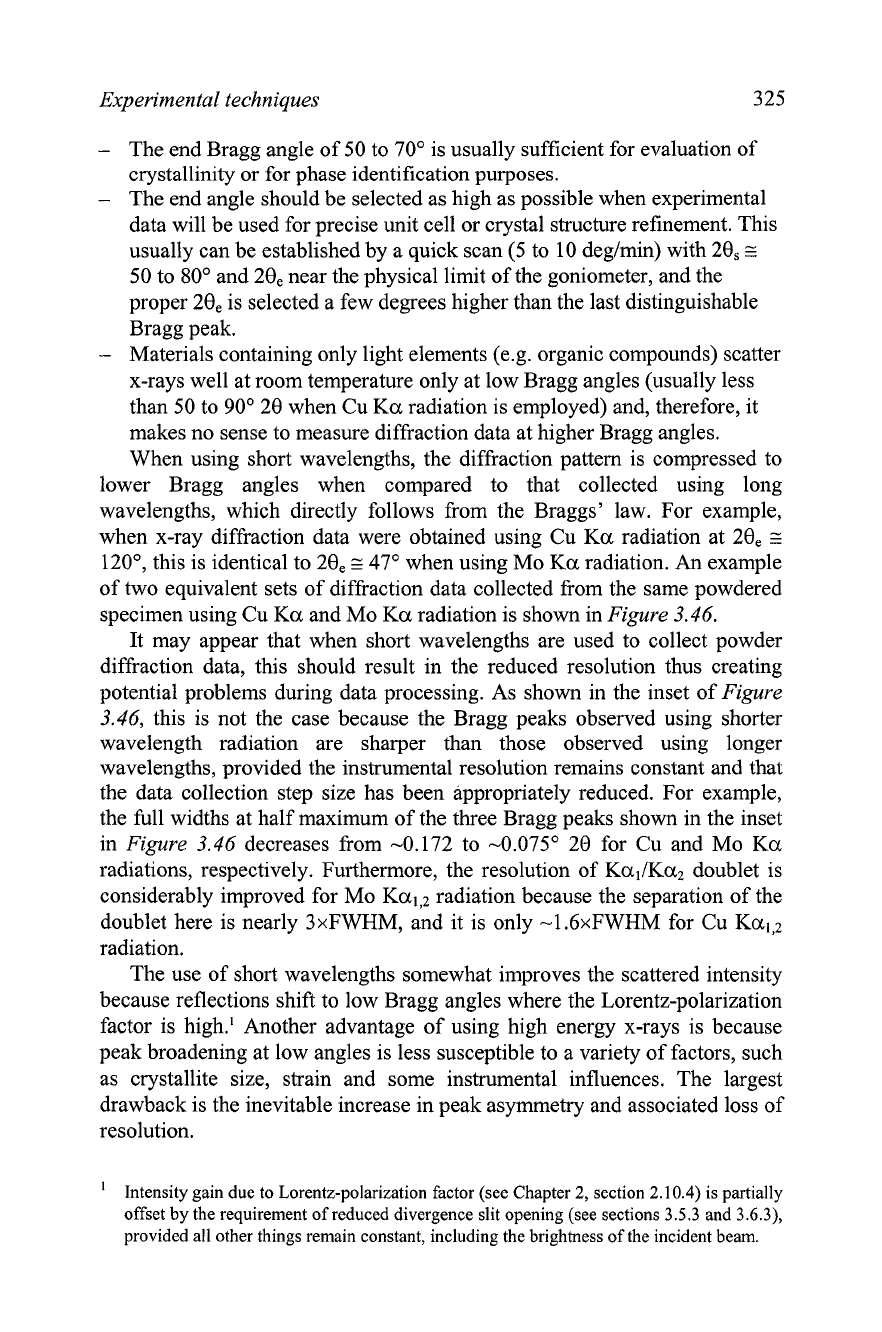
Experimental techniques
325
-
The end Bragg angle of 50 to 70•‹ is usually sufficient for evaluation of
crystallinity or for phase identification purposes.
-
The end angle should be selected as high as possible when experimental
data will be used for precise unit cell or crystal structure refinement. This
usually can be established by a quick scan (5 to 10
deglmin) with 28,
z
50 to 80' and 28, near the physical limit of the goniometer, and the
proper 28, is selected a few degrees higher than the last distinguishable
Bragg peak.
-
Materials containing only light elements (e.g. organic compounds) scatter
x-rays well at room temperature only at low Bragg angles (usually less
than 50 to 90' 28 when Cu Ka radiation is employed) and, therefore, it
makes no sense to measure diffraction data at higher Bragg angles.
When using short wavelengths, the diffraction pattern is compressed to
lower Bragg angles when compared to that collected using long
wavelengths, which directly follows from the Braggs' law. For example,
when x-ray diffraction data were obtained using Cu
Ka radiation at 28,
z
120•‹, this is identical to 28,
E
47' when using Mo Ka radiation. An example
of two equivalent sets of diffraction data collected from the same powdered
specimen using Cu Ka and Mo Ka radiation is shown in
Figure
3.46.
It may appear that when short wavelengths are used to collect powder
diffraction data, this should result in the reduced resolution thus creating
potential problems during data processing. As shown in the inset of
Figure
3.46, this is not the case because the Bragg peaks observed using shorter
wavelength radiation are sharper than those observed using longer
wavelengths, provided the instrumental resolution remains constant and that
the data collection step size has been appropriately reduced. For example,
the full widths at half maximum of the three Bragg peaks shown in the inset
in
Figure
3.46 decreases from -0.172 to -0.075' 28 for Cu and Mo Ka
radiations, respectively. Furthermore, the resolution of KallKa2 doublet is
considerably improved for Mo Kal,2 radiation because the separation of the
doublet here is nearly
3xFWHM, and it is only -1.6xFWHM for Cu Kal,z
radiation.
The use of short wavelengths somewhat improves the scattered intensity
because reflections shift to low Bragg angles where the Lorentz-polarization
factor is highs1 Another advantage of using high energy x-rays is because
peak broadening at low angles is less susceptible to a variety of factors, such
as crystallite size, strain and some instrumental influences. The largest
drawback is the inevitable increase in peak asymmetry and associated loss of
resolution.
Intensity gain due to Lorentz-polarization factor (see Chapter 2, section 2.10.4) is partially
offset
by
the requirement of reduced divergence slit opening (see sections 3.5.3 and 3.6.3),
provided all other things remain constant, including the brightness of the incident beam.
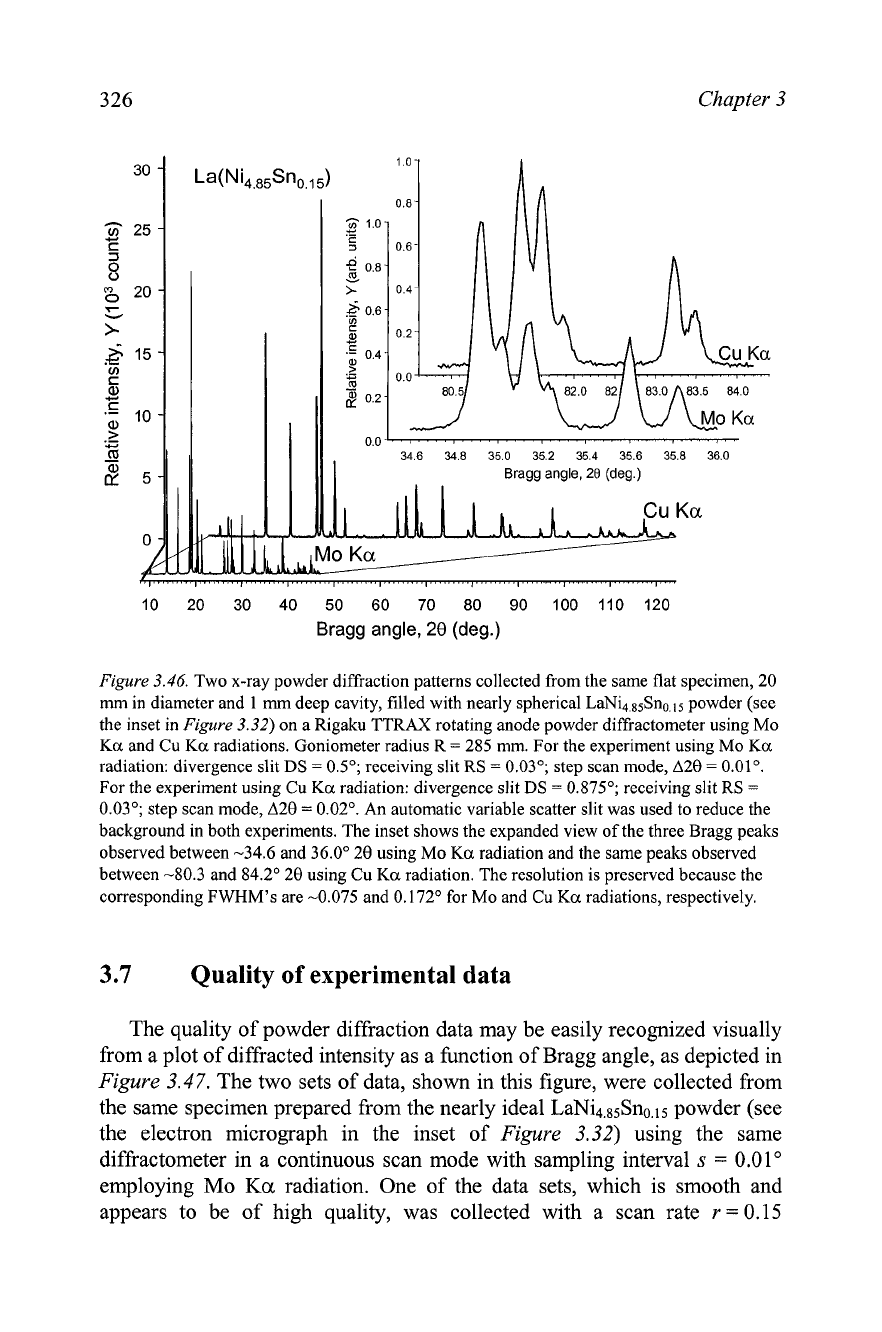
Chapter
3
34.6
34.8
35.0 35.2 35.4 35.6 35.8 36.0
Bragg angle,
20
(deg.)
10 20 30 40 50 60 70
80
90 100110120
Bragg angle,
20
(deg.)
Figure
3.46.
Two x-ray powder diffraction patterns collected from the same flat specimen, 20
mrn
in diameter and
1
mm
deep cavity, filled with nearly spherical LaNi4 asSno,ls powder (see
the inset in
Figure
3.32)
on a Rigaku TTRAX rotating anode powder diffractometer using Mo
Ka
and Cu
Ka
radiations. Goniometer radius
R
=
285 mm. For the experiment using Mo
Ka
radiation: divergence slit DS
=
0.5'; receiving slit RS
=
0.03'; step scan mode,
A28
=
0.01'.
For the experiment using Cu
Ka
radiation: divergence slit DS
=
0.875'; receiving slit RS
=
0.03"; step scan mode, A20
=
0.02".
An
automatic variable scatter slit was used to reduce the
background in both experiments. The inset shows the expanded view of the three Bragg peaks
observed between -34.6 and 36.0" 20 using Mo
Ka
radiation and the same peaks observed
between -80.3 and 84.2" 20 using Cu
Ka
radiation. The resolution is preserved because the
corresponding FWHM's are -0.075 and 0.172" for Mo and Cu
Ka
radiations, respectively.
3.7
Quality
of
experimental data
The quality of powder diffraction data may be easily recognized visually
from a plot of diffracted intensity as a function of Bragg angle, as depicted in
Figure
3.47.
The two sets of data, shown in this figure, were collected from
the same specimen prepared from the nearly ideal LaNi4.85Sno.15 powder (see
the electron micrograph in the inset of
Figure
3.32)
using the same
diffractometer in a continuous scan mode with sampling interval
s
=
0.01"
employing Mo
Ka
radiation. One of the data sets, which is smooth and
appears to be of high quality, was collected with a scan rate
r
=
0.15
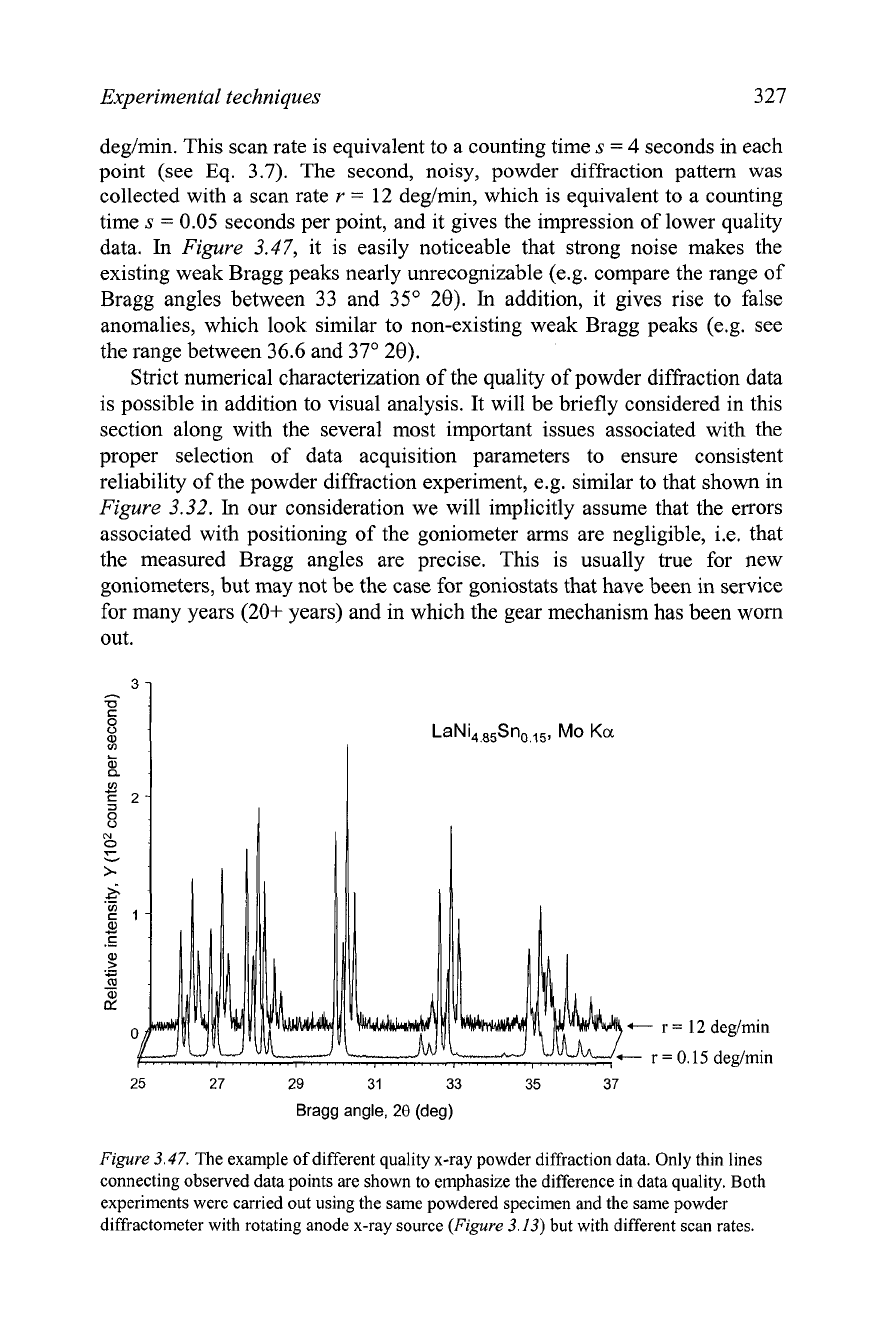
Experimental techniques
327
deglmin. This scan rate is equivalent to a counting time
s
=
4
seconds in each
point (see Eq. 3.7). The second, noisy, powder diffraction pattern was
collected with a scan rate
r
=
12
deglmin, which is equivalent to a counting
time
s
=
0.05 seconds per point, and it gives the impression of lower quality
data.
In
Figure
3.47, it is easily noticeable that strong noise makes the
existing weak Bragg peaks nearly unrecognizable (e.g. compare the range of
Bragg angles between 33 and
35"
29).
In
addition, it gives rise to false
anomalies, which look similar to non-existing weak Bragg peaks (e.g. see
the range between
36.6
and 37" 28).
Strict numerical characterization of the quality of powder diffraction data
is possible in addition to visual analysis. It will be briefly considered in this
section along with the several most important issues associated with the
proper selection of data acquisition parameters to ensure consistent
reliability of the powder diffraction experiment,
e.g. similar to that shown in
Figure
3.32.
In
our consideration we will implicitly assume that the errors
associated with positioning of the goniometer arms are negligible, i.e. that
the measured Bragg angles are precise. This is usually true for new
goniometers, but may not be the case for goniostats that have been in service
for many years
(20+ years) and in which the gear mechanism has been worn
29
31
33
35
37
Bragg angle,
20
(deg)
Figure
3.47.
The example of different quality x-ray powder diffraction data. Only thin lines
connecting observed data points are shown to emphasize the difference in data quality. Both
experiments were carried out using the same powdered specimen and the same powder
diffractometer with rotating anode x-ray source
(Figure
3.13)
but with different scan rates.
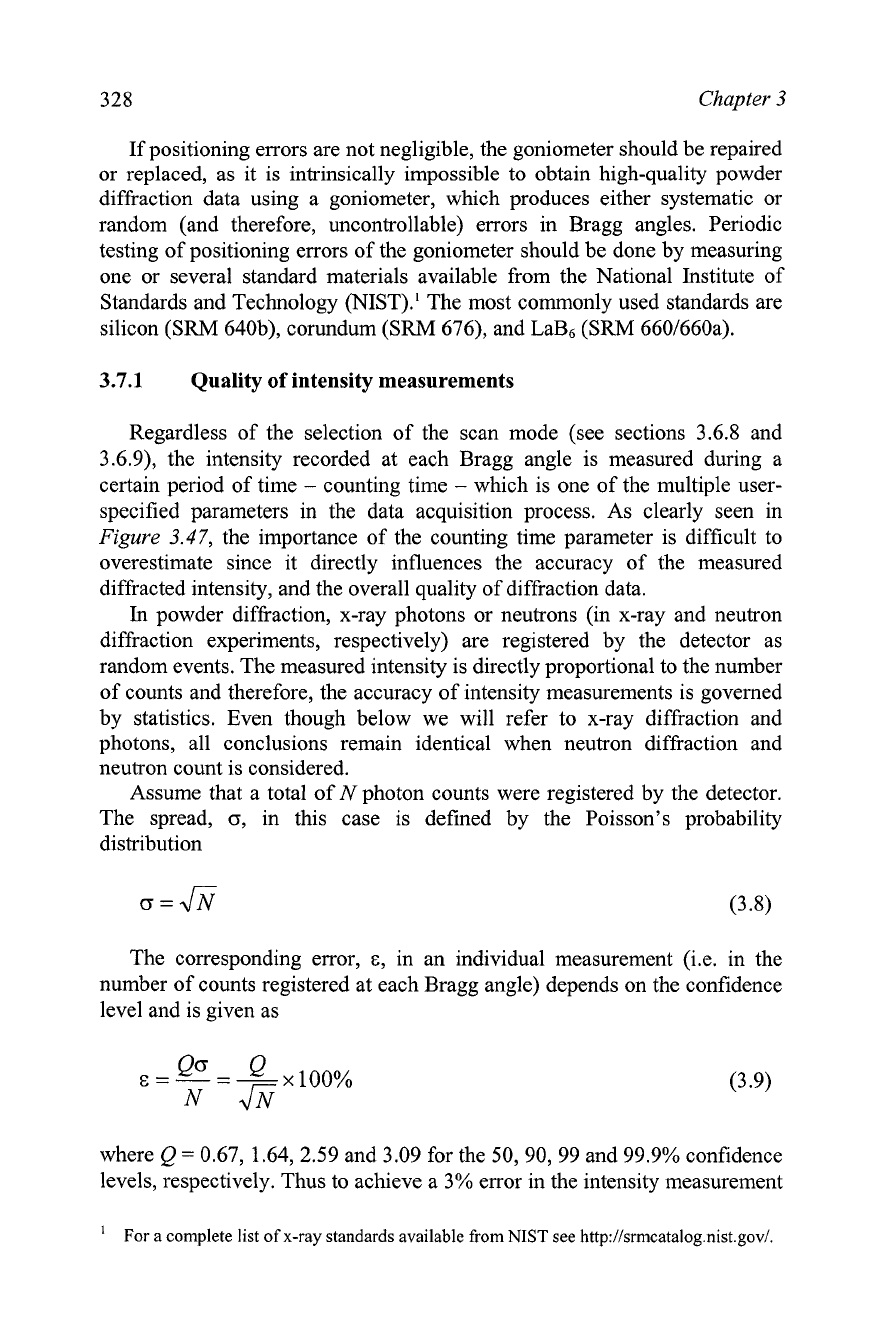
328
Chapter
3
If positioning errors are not negligible, the goniometer should be repaired
or replaced, as it is intrinsically impossible to obtain high-quality powder
diffraction data using a goniometer, which produces either systematic or
random (and therefore, uncontrollable) errors in Bragg angles. Periodic
testing of positioning errors of the goniometer should be done by measuring
one or several standard materials available from the National Institute of
Standards and Technology
(NIST).' The most commonly used standards are
silicon (SRM 640b), corundum (SRM 676), and LaB6
(SRM
6601660a).
3.7.1
Quality
of
intensity measurements
Regardless of the selection of the scan mode (see sections 3.6.8 and
3.6.9), the intensity recorded at each Bragg angle is measured during a
certain period of time
-
counting time
-
which is one of the multiple user-
specified parameters in the data acquisition process. As clearly seen in
Figure
3.47, the importance of the counting time parameter is difficult to
overestimate since it directly influences the accuracy of the measured
diffracted intensity, and the overall quality of diffraction data.
In
powder diffraction, x-ray photons or neutrons (in x-ray and neutron
diffraction experiments, respectively) are registered by the detector as
random events. The measured intensity is directly proportional to the number
of counts and therefore, the accuracy of intensity measurements is governed
by statistics. Even though below we will refer to x-ray diffraction and
photons, all conclusions remain identical when neutron diffraction and
neutron count is considered.
Assume that a total of
N
photon counts were registered by the detector.
The spread,
o,
in this case is defined by the Poisson's probability
distribution
The corresponding error,
E,
in an individual measurement (i.e. in the
number of counts registered at each Bragg angle) depends on the confidence
level and is given as
where
Q
=
0.67, 1.64,2.59 and 3.09 for the 50,90, 99 and 99.9% confidence
levels, respectively. Thus to achieve a 3% error in the intensity measurement
For a complete list of x-ray standards available from
NIST
see
http:Nsrmcatalog.nist.gov/.
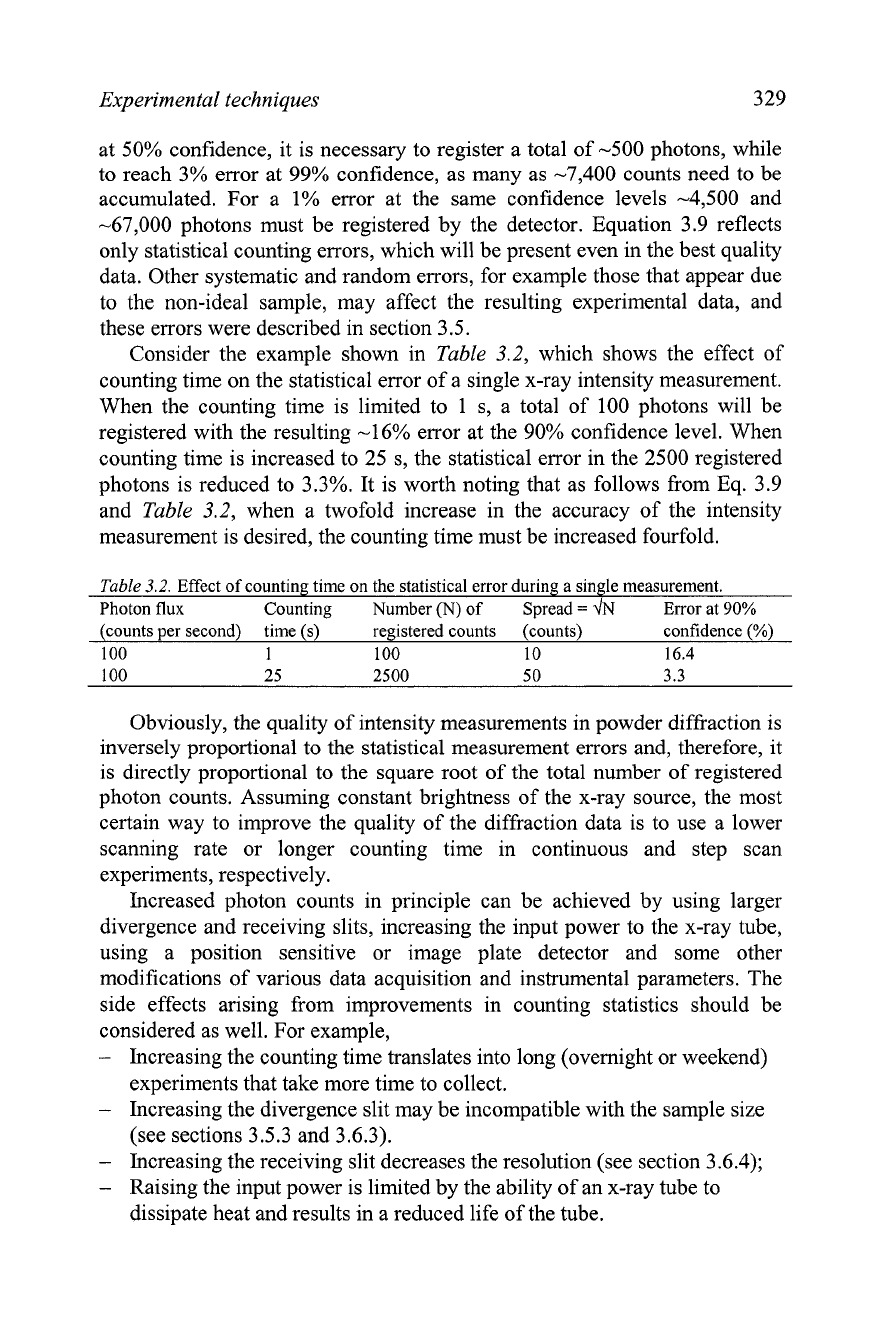
Experimental techniques
329
at 50% confidence, it is necessary to register a total of -500 photons, while
to reach 3% error at 99% confidence, as many as -7,400 counts need to be
accumulated. For a 1% error at the same confidence levels -4,500 and
-67,000 photons must be registered by the detector. Equation 3.9 reflects
only statistical counting errors, which will be present even in the best quality
data. Other systematic and random errors, for example those that appear due
to the non-ideal sample, may affect the resulting experimental data, and
these errors were described in section 3.5.
Consider the example shown in
Table
3.2, which shows the effect of
counting time on the statistical error of a single x-ray intensity measurement.
When the counting time is limited to 1 s, a total of 100 photons will be
registered with the resulting -16% error at the 90% confidence level. When
counting time is increased to 25 s, the statistical error in the 2500 registered
photons is reduced to 3.3%. It is worth noting that as follows from Eq. 3.9
and
Table
3.2, when a twofold increase in the accuracy of the intensity
measurement is desired, the counting time must be increased fourfold.
Table
3.2.
Effect of counting time on the statistical error during a single measurement.
Photon flux Counting Number
(N)
of Spread
=
4~
Error at
90%
(counts per second) time (s) registered counts (counts) confidence
(%)
100
1
100 10 16.4
100 25 2500 5 0
3.3
Obviously, the quality of intensity measurements in powder diffraction is
inversely proportional to the statistical measurement errors and, therefore, it
is directly proportional to the square root of the total number of registered
photon counts. Assuming constant brightness of the x-ray source, the most
certain way to improve the quality of the diffraction data is to use a lower
scanning rate or longer counting time in continuous and step scan
experiments, respectively.
Increased photon counts in principle can be achieved by using larger
divergence and receiving slits, increasing the input power to the x-ray tube,
using a position sensitive or image plate detector and some other
modifications of various data acquisition and instrumental parameters. The
side effects arising from improvements in counting statistics should be
considered as well. For example,
-
Increasing the counting time translates into long (overnight or weekend)
experiments that take more time to collect.
-
Increasing the divergence slit may be incompatible with the sample size
(see sections 3.5.3 and 3.6.3).
-
Increasing the receiving slit decreases the resolution (see section 3.6.4);
-
Raising the input power is limited by the ability of an x-ray tube to
dissipate heat and results in a reduced life of the tube.
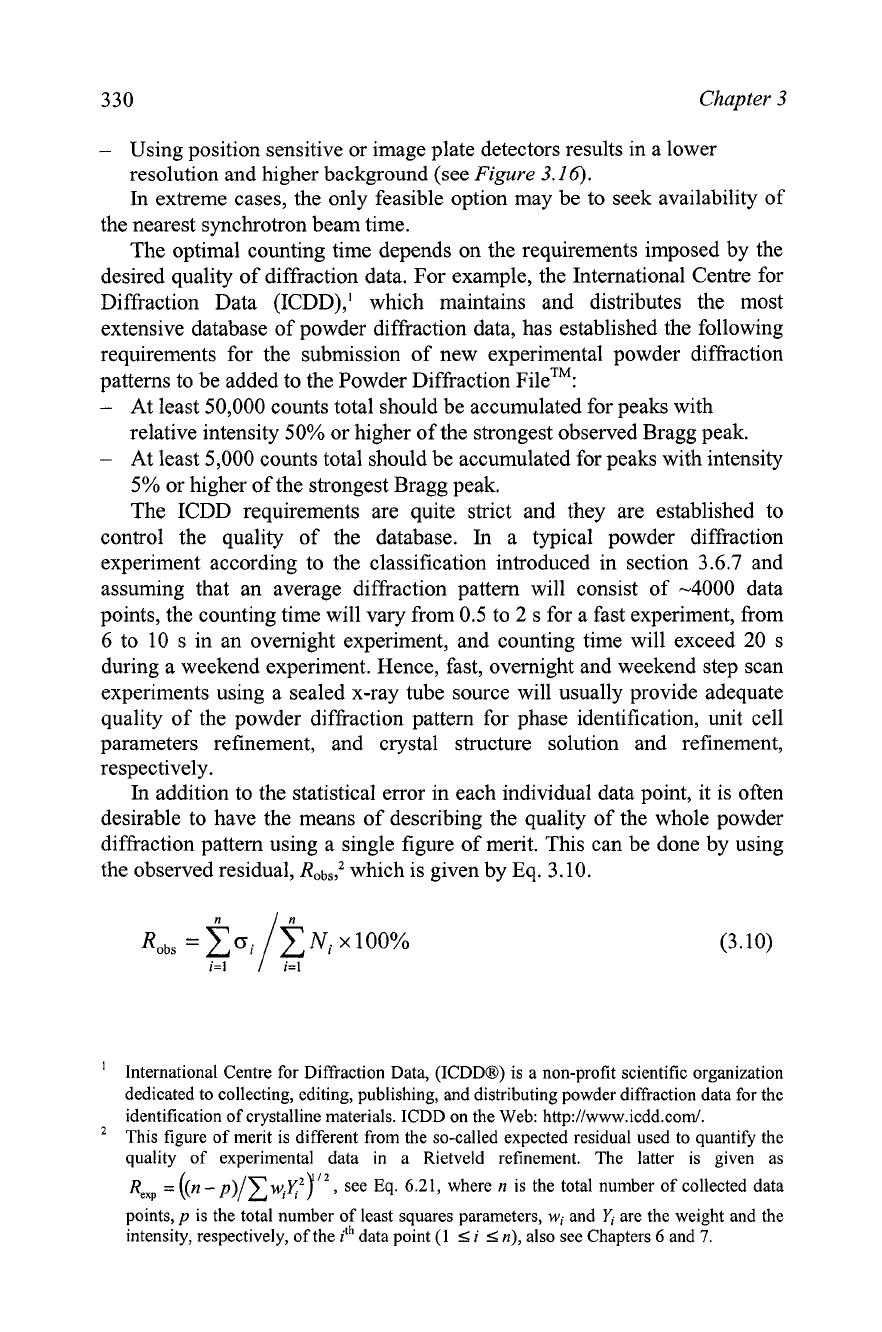
330
Chapter
3
-
Using position sensitive or image plate detectors results in a lower
resolution and higher background (see
Figure
3.16).
In
extreme cases, the only feasible option may be to seek availability of
the nearest synchrotron beam time.
The optimal counting time depends on the requirements imposed by the
desired quality of diffraction data. For example, the International Centre for
Diffraction Data (ICDD),' which maintains and distributes the most
extensive database of powder diffraction data, has established the following
requirements for the submission of new experimental powder diffraction
patterns to be added to the Powder Diffraction
~ile~~:
-
At least 50,000 counts total should be accumulated for peaks with
relative intensity 50% or higher of the strongest observed Bragg peak.
-
At least 5,000 counts total should be accumulated for peaks with intensity
5% or higher of the strongest Bragg peak.
The ICDD requirements are quite strict and they are established to
control the quality of the database. In a typical powder diffraction
experiment according to the classification introduced in section 3.6.7 and
assuming that an average diffraction pattern will consist of -4000 data
points, the counting time will vary from 0.5 to 2 s for a fast experiment, from
6 to 10 s in an overnight experiment, and counting time will exceed 20
s
during a weekend experiment. Hence, fast, overnight and weekend step scan
experiments using a sealed x-ray tube source will usually provide adequate
quality of the powder diffraction pattern for phase identification, unit cell
parameters refinement, and crystal structure solution and refinement,
respectively.
In addition to the statistical error in each individual data point, it is often
desirable to have the means of describing the quality of the whole powder
diffraction pattern using a single figure of merit. This can be done by using
the observed residual,
Rob,:
which is given by Eq. 3.10.
'
International Centre for Diffraction Data, (ICDDB) is a non-profit scientific organization
dedicated to collecting, editing, publishing, and distributing powder diffraction data for the
identification of crystalline materials. ICDD on the Web: http://www.icdd.com/.
This figure of merit is different from the so-called expected residual used to quantify the
quality of experimental data in a Rietveld refinement. The latter is given as
Rex,
=
((n
-p)/~wil;2Y'2,
see Eq.
6.21,
where
n
is the total number of collected data
points,
p
is the total number of least squares parameters,
wi
and
Yi
are the weight and the
intensity, respectively, of the
ith
data point
(1
I
i
In),
also see Chapters
6
and
7.
